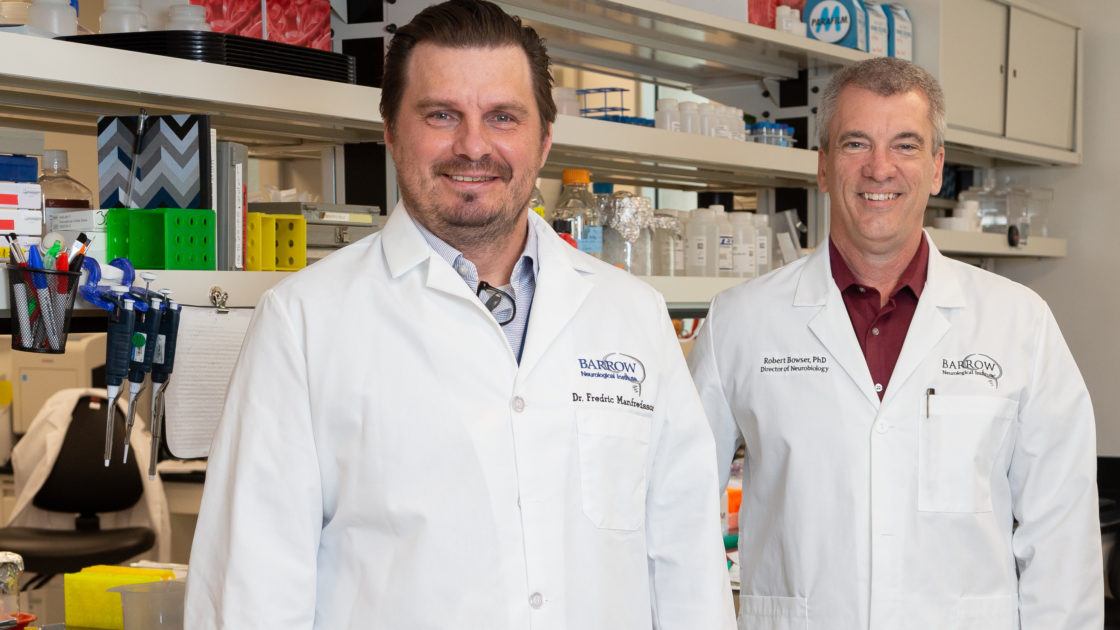
Barrow Researchers Receive DoD Grant for New ALS Therapy
The Department of Defense (DoD) has awarded a grant of $881,300 entitled “Targeting CNS expression of chitinases as a novel therapy for ALS” to two scientists at Barrow Neurological Institute to study a new therapeutic approach for amyotrophic lateral sclerosis (ALS).
The highly competitive, two-year grant will support Dr. Robert Bowser and Dr. Fredric Manfredsson in their efforts to target specific inflammatory cells involved in ALS and “flip” them from being harmful to beneficial.
ALS, also known as Lou Gehrig’s disease, causes the nerve cells responsible for muscle movements to deteriorate and die. Over time, people with ALS may lose their ability to move, speak, eat, and breathe.
The research funded by the DoD builds on Dr. Bowser’s work in chitinases. His laboratory has observed these proteins in higher levels in people with ALS but also in cells that control inflammation in nervous tissue.
“For years, we talked about neuroinflammation being bad,” said Dr. Bowser, chair of the Department of Neurobiology and chief scientific officer at Barrow. “Then, over time, we found that some types of inflammation are actually good; they’re protective.”
The challenge, however, is specifically targeting and disrupting the “bad” inflammation while preserving and promoting the “good” inflammation in patients with ALS.
“If you try to do this in a more standardized treatment like a drug, you can’t fine-tune it,” Dr. Bowser said, explaining that studies of anti-inflammatory drugs for ALS patients have failed. “You’re going to deliver that drug everywhere in the body or central nervous system.”
Viral Vectors: A Targeted Approach to Regulating Inflammation in ALS
That’s why Dr. Bowser is collaborating with Dr. Manfredsson, whose research at Barrow is primarily in Parkinson’s disease but whose tools could be the perfect solution for this challenge.
Dr. Manfredsson develops viral vectors for genetic therapies. This concept involves using a virus as a carrier for delivering a therapeutic gene into the body. Although the virus works by getting inside cells, it’s modified so that it does not cause any disease. The inserted gene either corrects an abnormal gene or creates a helpful protein.
“So we thought, hey, why don’t we merge our expertise together and develop a new class of these vectors that target the inflammatory cells?” Dr. Bowser said. “The goal of the project is to both identify those viral vectors, which would be completely new discoveries, and then use them to take these inflammatory cells that are causing cell death and flip them to become more neuroprotective.”
In other words, the virus would carry instructions telling certain cells to either turn on or turn off chitinase gene expression—either halting or encouraging inflammation.
This grant will also allow Dr. Bowser and Dr. Manfredsson to validate their tools for measuring chitinases in the blood and cerebrospinal fluid of patients. These tools could then be used to evaluate how well viral vector-based treatments are working in humans down the road.
“So it’s sort of a two-pronged approach: Can we develop a new therapy, and can we develop and validate biomarkers that we can then use to monitor patients during treatment?” Dr. Bowser said.
Chitinase Findings in Parkinson’s, Alzheimer’s Suggest Potential for Broader Impact
Dr. Manfredsson said they’ll also test their technology in a variety of disease models to look for broader applications. Studies have shown increased levels of chitinases in Parkinson’s and Alzheimer’s diseases.
“Yes, this grant is for ALS, but these tools could be extended to these other neurodegenerative diseases,” Dr. Manfredsson said. “We’re going to kind of look across the spectrum.”
It’s a quintessential Barrow collaboration: neuroscience experts with different subspecialties pursuing a cutting-edge treatment to help patients under their own roof.
“The excitement is the novelty of the approach, the more broad utility of it, and ultimately the fact that it could move forward and help our patient population,” Dr. Bowser said.
